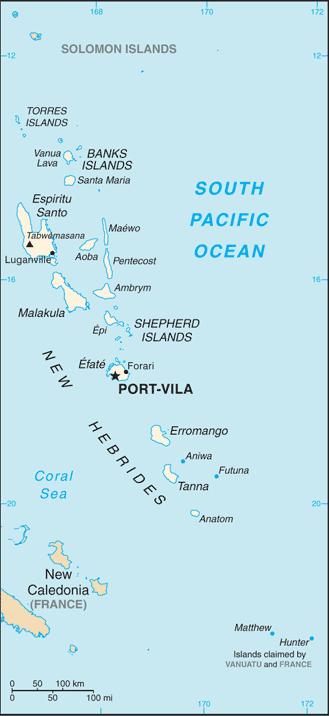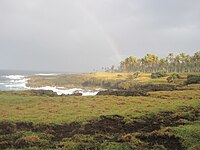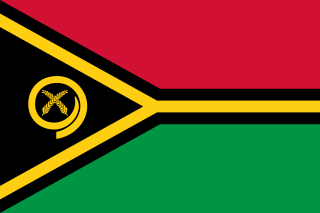
Vanuatu, officially the Republic of Vanuatu, is an island country located in the South Pacific Ocean. The archipelago, which is of volcanic origin, is 1,750 kilometres (1,090 mi) east of northern Australia, 540 kilometres (340 mi) northeast of New Caledonia, east of New Guinea, southeast of the Solomon Islands, and west of Fiji.
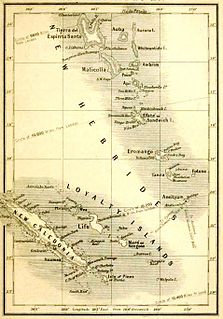
The history of Vanuatu begins obscurely. The commonly held theory of Vanuatu's prehistory from archaeological evidence supports that peoples speaking Austronesian languages first came to the islands some 3,300 years ago. Pottery fragments have been found dating back to 1300 BC. What little is known of the pre-European contact history of Vanuatu has been gleaned from oral histories and legends. One important early king was Roy Mata, who united several tribes, and was buried in a large mound with several retainers.
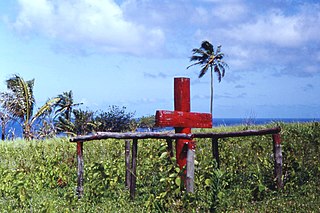
A cargo cult is a indigenist millenarian belief system in which adherents perform rituals which they believe will cause a more technologically advanced society to deliver goods. These cults were first described in Melanesia in the wake of contact with allied military forces during the Second World War.

John Frum is a figure associated with cargo cults on the island of Tanna in Vanuatu. He is often depicted as an American World War II serviceman who will bring wealth and prosperity to the people if they follow him. Quoting David Attenborough's report of an encounter: "'E look like you. 'E got white face. 'E tall man. 'E live 'long South America."
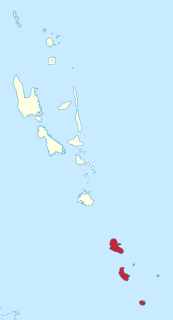
Tafea is the southernmost of the six provinces of Vanuatu.

Vanuatu has been divided into six provinces since 1994. The names in English of all provinces are derived from the initial letters of their constituent islands:
The nine South Vanuatu languages form a family of the Southern Oceanic languages, spoken in Tafea Province of Vanuatu.
Futuna is an island in the Tafea province of Vanuatu. It is the easternmost island in the country.

Erromango is the fourth largest island in the Vanuatu archipelago. With a land area of 891.9 square kilometres (344.4 sq mi) it is the largest island in Tafea Province, the southernmost of Vanuatu's six administrative regions.

Aniwa is a small island in the southernmost province of Tafea, Vanuatu.

Mount Yasur is a volcano on Tanna Island, Vanuatu, 361 m (1,184 ft) high above sea level, on the coast near Sulphur Bay, northeast of the taller Mount Tukosmera, which was active in the Pleistocene. It has a largely unvegetated pyroclastic cone with a nearly circular summit crater 400 m in diameter. It is a stratovolcano, caused by the eastward-moving Indo-Australian Plate being subducted under the westward-moving Pacific Plate. It has been erupting nearly continuously for several hundred years, although it can usually be approached safely. Its eruptions, which often occur several times an hour, are classified as Strombolian or Vulcanian. A large lava plain creeps across the valley at the base.

Isangel is a town in Vanuatu.
Sulphur Bay is a bay on the eastern side of Tanna island in Vanuatu. Nearby is Mount Yasur, called the world's most accessible volcano. The area is the center of the John Frum cargo cult, a movement that believes their savior, an American World War II GI, resides within Yasur with his men. Sulphur Bay was the first part of the island visited by Westerners, when the glow of Mount Yasur attracted James Cook in 1774.

The Prince Philip movement is a religious sect followed by the Kastom people around the villages of Yaohnanen and Yakel on the southern island of Tanna in Vanuatu. It is a cargo cult of the Yaohnanen tribe, who believe in the divinity of Prince Philip, Duke of Edinburgh (1921–2021), the former consort to Queen Elizabeth II.

Approximately 83% of the population of Vanuatu is Christian. An estimated 32% is Presbyterian, 13% Roman Catholic, 13% Anglican, and 11% Seventh-day Adventist. Groups that together constitute 14% include the Church of Christ 3.8%, United Pentecostal Church UPCIV Assemblies of God, and other Christian denominations.

This article presents an overview of the culture of Vanuatu.
Vanuatu, officially known as the Republic of Vanuatu, is an island nation located in the South Pacific Ocean. The archipelago, which is of volcanic origin, is some 1,750 kilometres (1,090 mi) east of northern Australia, 500 kilometres (310 mi) north-east of New Caledonia, west of Fiji, and southeast of the Solomon Islands, near New Guinea. The nation's largest town and the capital Port Vila is situated on Efate Island.
Lenakel, or West Tanna, is a dialect chain spoken on the western coast of Tanna Island in Vanuatu.

Tanna is a 2015 Australian-Ni-Vanuatu film set on the island of Tanna in the South Pacific, depicting the true story of a couple who decided to marry for love, rather than obey their parents' wishes. Starring Marie Wawa and Mungau Dain, the film is based on an actual marriage dispute.

The Victoria-Vanuatu Physician Project (ViVa) was a Canadian non-governmental organization of physicians and their families from Victoria, British Columbia, Canada. For 24 years it supplied a medical doctor to the island of Tanna, Vanuatu.




